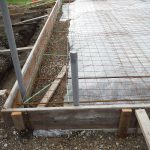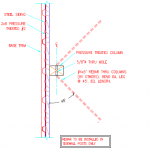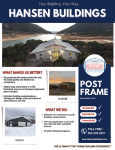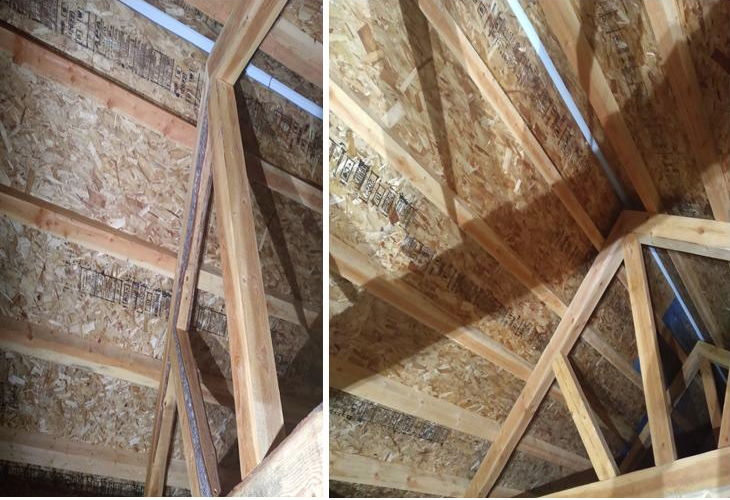Long time readers will recall concrete finishing does not rank amongst my favorite building tasks. It is an art form with a gene I was not blessed with. Most pole barns, post frame buildings and barndominiums utilize slabs poured on grade.
Reader KYLE in KAPLAN writes:
“In your pole barns, do you typically use wire mesh, or rebar when doing a slab?”
For areas where heavy vehicles or equipment may be placed, our independent third-party engineers will specify rebar reinforcement for concrete slabs on grade. Much of your need for reinforcement will be dictated by how well your site was prepared. Properly compacted sub-grades can reduce needs for reinforcement – as well compacted site is less prone to adverse effects from uneven weight distributions. Sadly, most clients and builders just do not spend enough time and effort to arrive at good site preparation.
Choosing concrete for a residential or commercial construction project is a great way to ensure you are using a strong, durable material. There are several ways to make sure your concrete has proper strength for your building. Concrete changes density when it sets, making it vulnerable to cracking. Concrete also can crack due to changes in temperature or unevenly distributed weight or stress. When pouring concrete for driveways, foundations, or floors, three common ways to reinforce concrete are to use wire mesh, rebar or fibers.
 Using wire mesh is a common method to reinforce poured concrete. Wire mesh makes a square grid pattern and is laid down before concrete gets poured. Wire mesh is usually one layer of a two-dimensional grid running along length and width of poured concrete, but not height. During concrete pouring processes, you or your workers will raise previously laid down wire so it runs along concrete height (thickness) middle. This reinforcing material inside helps to prevent cracking during temperature changes and while concrete is setting.
Using wire mesh is a common method to reinforce poured concrete. Wire mesh makes a square grid pattern and is laid down before concrete gets poured. Wire mesh is usually one layer of a two-dimensional grid running along length and width of poured concrete, but not height. During concrete pouring processes, you or your workers will raise previously laid down wire so it runs along concrete height (thickness) middle. This reinforcing material inside helps to prevent cracking during temperature changes and while concrete is setting.
Instead of laying down a wire mesh before concrete is poured, using fiber mesh involves mixing in different fibers such as glass, steel, synthetic fibers, or natural fibers. Fiber mesh reinforces concrete throughout its entire structure rather than just one plane. This comprehensive reinforcement protects against not just cracking due to fluctuating temperatures and changing densities from setting, but also helps prevent water from bleeding out of concrete and gives concrete’s surface a higher impact resistance.
In addition to providing a more thorough protection for your concrete pour, fiber mesh typically takes less time than wire mesh to use. This is because wire mesh has to be carefully measured to fit the pour site and needs to be held up at a certain level during pouring processes. Conversely, fiber mesh can be added straight to mix, removing the need for an extra step while pouring. Fiber mesh is also more cost-effective since there is less time involved in pouring and material is used more efficiently. There has been concern among some as this fiber mesh method can create a “hairy” finish due to some fibers protruding from the slab’s surface. However, this is only temporary since they are often laid down flat when trowels flatten concrete’s surface, and any fibers still protruding are quickly worn down or burned off by the sun if outside, or a torch if indoors.
American Concrete Institute (ACI) lists factors playing a role in how thick covering concrete must be to support rebar.
Cast-in-place concrete requires placement of wet concrete around rebar, then holding it in place as it sets and dries around it. This is usually done with rebar supports helping hold it at correct depths, but this does open it up to a certain level of operator error.
For cast-in-place concrete in contact with ground permanently, recommended covering concrete thickness is three inches.
This means for cast-in-place slabs less than 5 inches thick, in most circumstances, there should be no rebar involved. Slabs at this thickness are simply too thin to adequately cover and protect rebar while still exploiting its reinforcing nature.
One thing certainly helping is to check your local regulations, as they take into consideration local environment for optimal construction.










We just went through some of this with a new concrete pad in front of the garage.
I had used the fibers many years ago when the garage was made, and they do stick through the surface and do result in small cracks at those locations. But that was the old days when fiber 1st came out.
As mentioned, there are different types and lengths of fiber now, for our pad they used a micro fiber, you can’t hardly find it even when looking.
This is the standard “mix” our guys (the contractor) use – 4500 psi mix plus “something” to help curing (it was getting late and we were pushing the temp limits) , micro fiber, plus a 30″ rebar grid, using fiber glass bar (no rust) (steel at the corners where it was bent) , 4″ thick with deeper areas at the edges. (I wanted a thicker pad but they said it wasn’t needed.)
We’ll see in 20-30 years how it holds up.